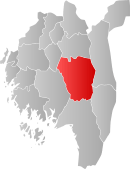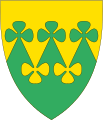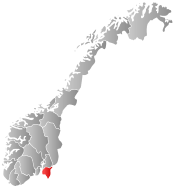Rakkestad
| Rakkestad kommune | |||
|---|---|---|---|
| Municipality | |||
 | |||
| |||
 Rakkestad within Østfold | |||
| Coordinates: 59°22′23″N 11°25′13″E / 59.37306°N 11.42028°ECoordinates: 59°22′23″N 11°25′13″E / 59.37306°N 11.42028°E | |||
| Country | Norway | ||
| County | Østfold | ||
| District | Smaalenene | ||
| Administrative centre | Rakkestad | ||
| Government | |||
| • Mayor (2007) | Peder Harlem (Sp) | ||
| Area | |||
| • Total | 435 km2 (168 sq mi) | ||
| • Land | 421 km2 (163 sq mi) | ||
| Area rank | 227 in Norway | ||
| Population (2004) | |||
| • Total | 7,232 | ||
| • Rank | 138 in Norway | ||
| • Density | 17/km2 (40/sq mi) | ||
| • Change (10 years) | 2.2 % | ||
| Demonym(s) | Raksting[1] | ||
| Time zone | CET (UTC+1) | ||
| • Summer (DST) | CEST (UTC+2) | ||
| ISO 3166 code | NO-0128 | ||
| Official language form | Bokmål | ||
| Website |
www | ||
|
| |||
Rakkestad is a municipality in Østfold county, Norway. The administrative centre of the municipality is the village of Rakkestad. It is divided into the parishes of Rakkestad, Degernes, and Os. The municipality is the county's second largest by area and one of Norway's largest agricultural areas.
Rakkestad was established as a municipality on 1 January 1838 (see formannskapsdistrikt). Degernes was separated from Rakkestad as a municipality of its own on 1 January 1917, but it was merged back into Rakkestad on 1 January 1964.
Rakkestad has a civil airport, Rakkestad Airport, Aastorp.
General information
Name
The municipality (originally the parish) is named after the old Rakkestad farm (Old Norse: Rakkastaðir). The first element is the genitive case of the Norse male name (nickname) Rakki and the last element is staðir meaning "homestead" or "farm".
Coat-of-arms
The coat-of-arms is from modern times. They were granted on 11 July 1975. The arms symbolize the fact that the main source of income in Rakkestad is agriculture. It shows a line of clover-shapes yellow on top and green on the bottom. The two lower leaves are symbols for the farming and forestry, and the upper symbolize the newer industries, trade, and crafts. The three standing clovers also represent the three parishes of the municipality: Rakkestad, Degernes and Os.[2]
Industry
Farming and forestry have always been important for settling and employment in Rakkestad. As a consequence the principal industries are growing grain, raising cattle, and dairy farming. Rakkestad has also developed a diversified economy based on agriculture and forestry such as poultry slaughterhouse and egg packing station, grain silo and mill, woodworking factories and agricultural machinery retailers. Traditional mechanical industry has developed into advanced technical industry directed towards the process, maritime, and offshore industry.
| Ancestry | Number |
|---|---|
| | 182 |
| | 134 |
| | 115 |
| | 100 |
| | 73 |
Nature
Rakkestad’s large areas of rolling, wooded hills offer excellent yearround recreational and leisure opportunities. There are marked forest paths for hiking and cross-country skiing.
Hunting
Rakkestad municipality offers small game hunting as well as roe deer hunting in the municipal forests, which cover about 18 square kilometres (7 sq mi). There are possibilities for farm lodging as well as cabin lodging.
Fishing
Landowners, angling clubs, and others put much work into cultivating waters and lakes to ensure good fishing. Most lakes are limed each year, with support from the government. Fry and fingerlings are also re-stocked annually. Where the cultivation is carried out with governmental funding, the fishing shall be available for all, either by free fishing or through open information about fishing licence and opportunities.
In Rakkestad more than 20 species of freshwater fish are registered. Many of these species lives in the Rakkestad River. The river meanders its way along, mainly through farmland, providing excellent river fishing for pike, roach, and perch.
Rakkestad is bordered to the west by River Glomma, Norway’s largest river. At Sutern in Os there is an outdoor recreation area equipped with toilet, open shelters, and areas for making a campfire. You can fish for 26 different species from a small jetty or from land along the river. Fishing licence for the area can be obtained fróm self-service boxes along the river.
In the Rakkestad Hills a number of small lakes offer the angler to fish in sheltered solitude. Although the pursuit of the large trout draws a number of anglers to the lakes, you will only occasionally happen to meet fellow anglers.
Most lakes can be reached by a short walk from the car. Some of the forest roads are private and one has to pay a small fee in a self-service box, normally about NOK 20. Fishing licences can be obtained in the same place. Normal price for the fishing licence is about NOK 40 for 24 hours or NOK 200 for a year.
Right of access
Everyone in Norway has a right of access to and passage through uncultivated land in the countryside, regardless of who owns it. On uncultivated land, you may go anywhere you like on foot or on skis and picnic wherever you want. You may also put up a tent for the night, but you must keep at least 150 metres (492.1 ft) away from the nearest house or cabin. If you want to stay for more than two nights in the same place, you must ask the landowner's permission. In the mountains or other remote areas you need no permission to camp.
Attractions

Rakkestad Church
Rakkestad Church (Rakkestad kirke) is a medieval era church. It was built ca. 1200. The Church is of Romanesque architecture style with rectangular ships and narrower and elongated choir. The building material is stone and brick. Rakkestad Church is first mentioned in written sources in 1370. In 1875 the church was extended with the sanctuary arch demolished and a new tower erected. The parish belongs to the Østre Borgesyssel deanery in the Diocese of Borg.[4][5] [6]
Linnekleppen
A visit to the fire lookout tower on Linnekleppen is recommended. Located at one of the highest peaks in the county 325 metres (1,066.3 ft) it overlooks the whole county, parts of neighbouring counties, and parts of Sweden. Linnekleppen is the only fire tower still in use in Norway.
Rudskogen Motorsenter
Rudskogen Motorsenter is the oldest asphalt racing ground in Norway opened in 1990. In 2006, the government decided to make Rudskogen Motorsenter the main centre for automobile and motorcycle sport. The aim is to develop the centre to be a flexible facility where capacity can be increased and several different activities can be conducted simultaneously. In co-operation with Borg MC, Sarpsborg and Rakkestad municipalities Rudskogen Motorsenter will offer an environment for almost every series in automobile and motorcycle sport.
References
- ↑ "Navn på steder og personer: Innbyggjarnamn" (in Norwegian). Språkrådet. Retrieved 2015-12-01.
- ↑ Norske Kommunevåpen (1990). "Nye kommunevåbener i Norden". Retrieved 2008-12-16.
- ↑ "Immigrants and Norwegian-born to immigrant parents, by immigration category, country background and percentages of the population". ssb.no. Retrieved 29 June 2015.
- ↑ Sigrid Marie Christie, Håkon Christie. "Rakkestad kirke". Norges Kirker. Retrieved October 1, 2016.
- ↑ Om Rakkestad kirke (Den Norske Kirke) Retrieved October 1, 2016.
- ↑ "Østre Borgesyssel prosti". arkivportalen. Retrieved October 1, 2016.
External links
| Wikimedia Commons has media related to Rakkestad. |
| Look up Rakkestad in Wiktionary, the free dictionary. |
- Rakkestad kirke
- Municipal fact sheet from Statistics Norway
-

Wikivoyage has a travel guide for Østfold.

